Diabetes in cats and dogs
understand and treat
A first step in dealing with diabetic pets is to understand the disease. The more you know about diabetes the better you will be able to take care about the health of your pet together with your veterinarian. It is important to know that the symptoms of people and pets with diabetes are similar, but for the measurement of blood glucose you will need different, specially calibrated testing devices.
6 out of 500 cats and 3 out of 500 dogs are diabetics.
Diabetes can be different from pet to pet. For this reason it is important to recognize related symptoms at an early stage and to discuss the findings with the veterinarian. In case of suspicion of diabetes further medical examinations have to be performed.
In case of suspicion of ketoacidosis – a severe complication of diabetes – your veterinarian can check the concentration of ketones in the blood of your pet by means of the WellionVet BELUA meter. The measurements can be performed in both capillary and venous blood.
If diabetes is detected at an early stage, health-related short- and longterm complications can be counteracted.
Regular blood glucose measurements play an important role in the successful treatment of diabetic animals. The blood glucose test should be performed under familiar conditions at home. In this case stress is reduced and your veterinarian will receive accurate data for the adaption of the diabetes therapy plan.
The WellionVet BELUA testing device has been developed especially for cats and dogs. For precise blood glucose and ketone results, special test strips and special code chips, dedicated to each species, are used.
Diabetes mellitus in animals
Diabetes Type 1
Frequent in dogs
Immune-mediated destruction of the beta cells of the pancreas
Absolute insulin deficiency
Increased Risk:
- Middle to higher age
- Breeds with a genetic predisposition for diabetes
- Additional trigger factors
Diabetes Type 2
Frequent in cats
Insulin resistance and dysfunction of the pancreatic beta cells
Increased risk:
- Higher age
- Neutered male cats
- Obesity
- Indoor cats
- Lack of physical activity
Diabetes Type 3
in dogs and cats
Secondary diabetes
- Triggered by other diseases (hyperthyroidism, acromegaly, hyperadrenocorticism,...), or medications (corticosteroids, progestagens) or pancreatic tumors.
- There is an increased risk for not-neutered female dogs.
Does your pet suffer from diabetes?
Recognize the symptoms!
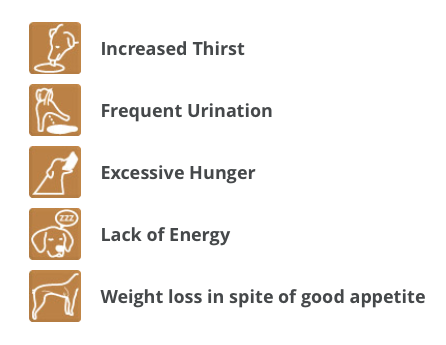
Why is home-monitoring of blood glucose important?
Blood glucose of animals can be influenced by various factors. The stress level of cats increases quickly under unusual situations like transport to the veterinarian or medical examinations. Stress-induced hyperglycemia is detected by high blood glucose levels. Therefore the diagnosis of diabetes cannot be made by just one single elevated blood glucose value.
Elevated blood glucose levels in dogs and cats can also occur together with diverse concomitant conditions like other hormonal diseases, chronic inflammation of the pancreas, some tumors, after traumas, neurological diseases or through some medication like e.g. longterm administration of glucocorticoids.
When performing the blood glucose test of your pet at home under relaxed usual conditions, the results are much more reliable and cause less stress for the pet and the owner.
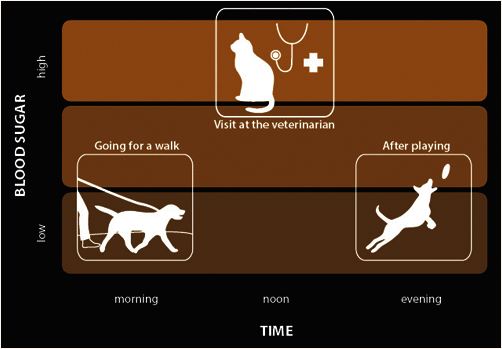
In order to be able to control the disease you have to check the blood sugar level on a regular base. These test results will lead from time to time to an adjustment of the treatment plan of your pet. The accurate results of the WellionVet blood measurement device are perfectly suitable for the evaluation through the veterinarian.
Important! Active dealing with diabetes, blood glucose monitoring at home under usual conditions and the competent care of your veterinarian contribute to a successful management of diabetes of your pet.
Why a special blood glucose meter for animals?
Different calibration of blood glucose meters of humans and animals
If a blood glucose meter calibrated on human blood is used for a cat or a dog, this can lead to inaccurate results by showing under- or overestimated readings.
A blood glucose meter for humans is calibrated for human blood parameters and evaluates the human blood glucose. The result differs from the one you get for cats and dogs. You need a special calibrated blood glucose meter for animals to get a reliable blood glucose value for your pet.
Your WellionVet BELUA blood glucose meter respects all these differences and is calibrated specially for cats and dogs.
A blood glucose meter for humans is calibrated for human blood parameters and evaluates the human blood glucose. The result differs from the one you get for cats and dogs. You need a special calibrated blood glucose meter for animals to get a reliable blood glucose value for your pet.
Your WellionVet BELUA blood glucose meter respects all these differences and is calibrated specially for cats and dogs.
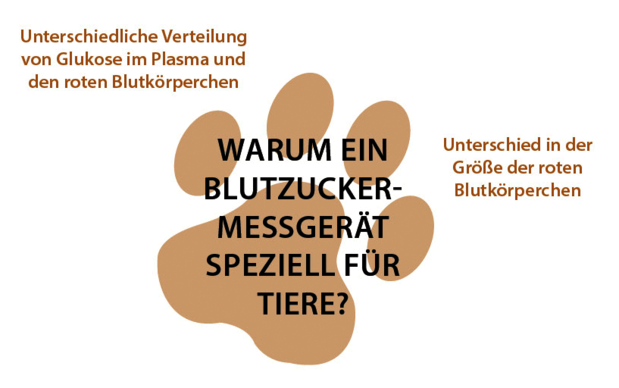
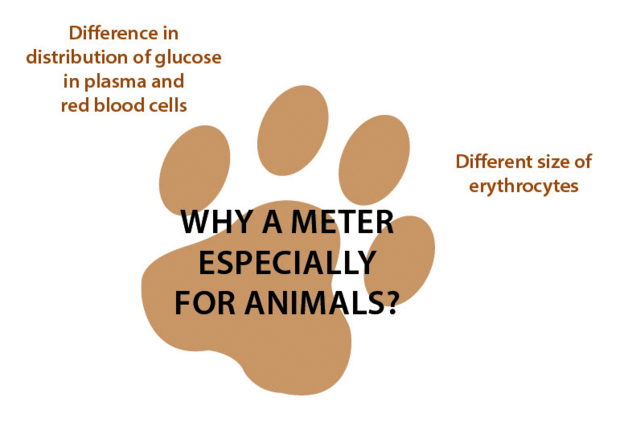
Blood from humans and animals is different!
The distribution of glucose in blood from humans and animals is different. On the one hand humans and animals have a different hematocrite value (human: 37-50%, dog: 37-55%, cat 27-47%), meaning that the number of red blood cells differs.
There is also a significant difference in the size of red blood cells of different species, therefore the percentage of glucose in plasma is diverse. In humans the part of glucose inside the red blood cells is about 42%, whereas about 58% of the glucose is situated in the plasma.
In cats (less and smaller red blood cells) the distribution of glucose is only about 7% inside the red blood cells and the major part of about 93% can be found in the plasma.
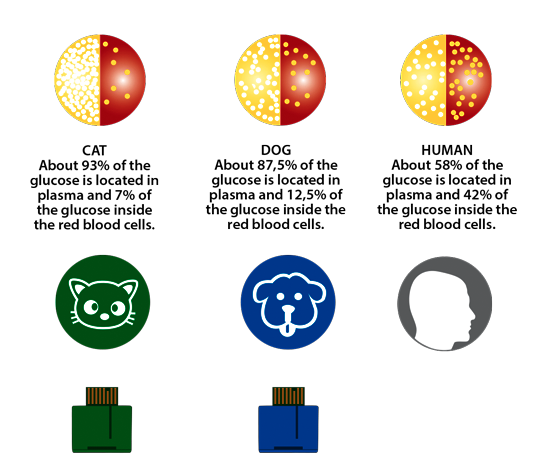
Correct blood sampling in animals
Where to get blood?
Ask your veterinarian for advice how to measure blood sugar levels at your pet. You will get information about the most appropriate sites for blood sampling.
You can use the following sites for getting a capillary blood sample for the blood glucose test:
- Inner part of the ear
- Paw pads
- Inner side of the lips
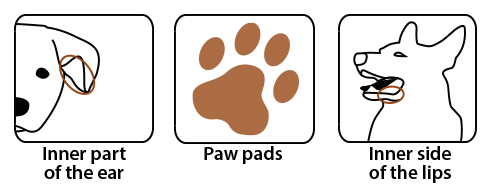
For a correct measurement only a small drop of blood is necessary.
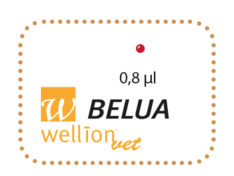
Useful information in the management of diabetes at animals
What's my task?
- Use exclusively WellionVet blood glucose meters which are specially developed and calibrated for animals.
- Test the blood glucose of your pet regularely according to the advice of your veterinarian.
- Note the blood glucose results, the amount of food, the dose of insulin and the testing time in the Wellion logbook.
- Inform your veterinarian if the test result is outside the range given by the veterinarian.
- If the tested blood glucose is below 70 mg/dl (3,9 mmol/l), test again to detect an upcoming hypoglycemia. You can treat hypoglycemia quickly by administration of Invertsugar Syrup.
- Feed only the amounts of food recommended by the veterinarian.
- Inform your veterinarian when you are aware of a change in behaviour of your pet.
What to avoid?
- Do not use blood glucose meters which are calibrated for humans.
- Do not reduce or increase the amount of food without consulting your veterinarian first
- Do not inject insulin which was not stored appropriately
- Do not change the dose of insulin without consulting your veterinarian first
- If your pet does not eat or vomits contact your veteriarian immediately
